Customer Service Management for Tourism and Hospitality: A Case Study of the Eden Project
VerifiedAdded on 2024/05/23
|15
|3944
|225
AI Summary
This study examines the customer service management practices of the Eden Project, a renowned tourist attraction in Cornwall, UK. It analyzes the cultural dimensions of the project, focusing on the differences between Chinese and British consumer behavior. The study utilizes Hofstede's cultural dimensions theory and the glocalization theory to evaluate the Eden Project's marketing mix and its adaptation to the local culture in China. It also explores the 7 Ps of service marketing and the factors that limit customer service, highlighting the benefits and opportunities that derive from customer expectations. The study concludes by presenting the good practices of the Eden Project in terms of cultural dimensions, staff training, branding, pricing policies, and customer service enhancement.
Contribute Materials
Your contribution can guide someone’s learning journey. Share your
documents today.
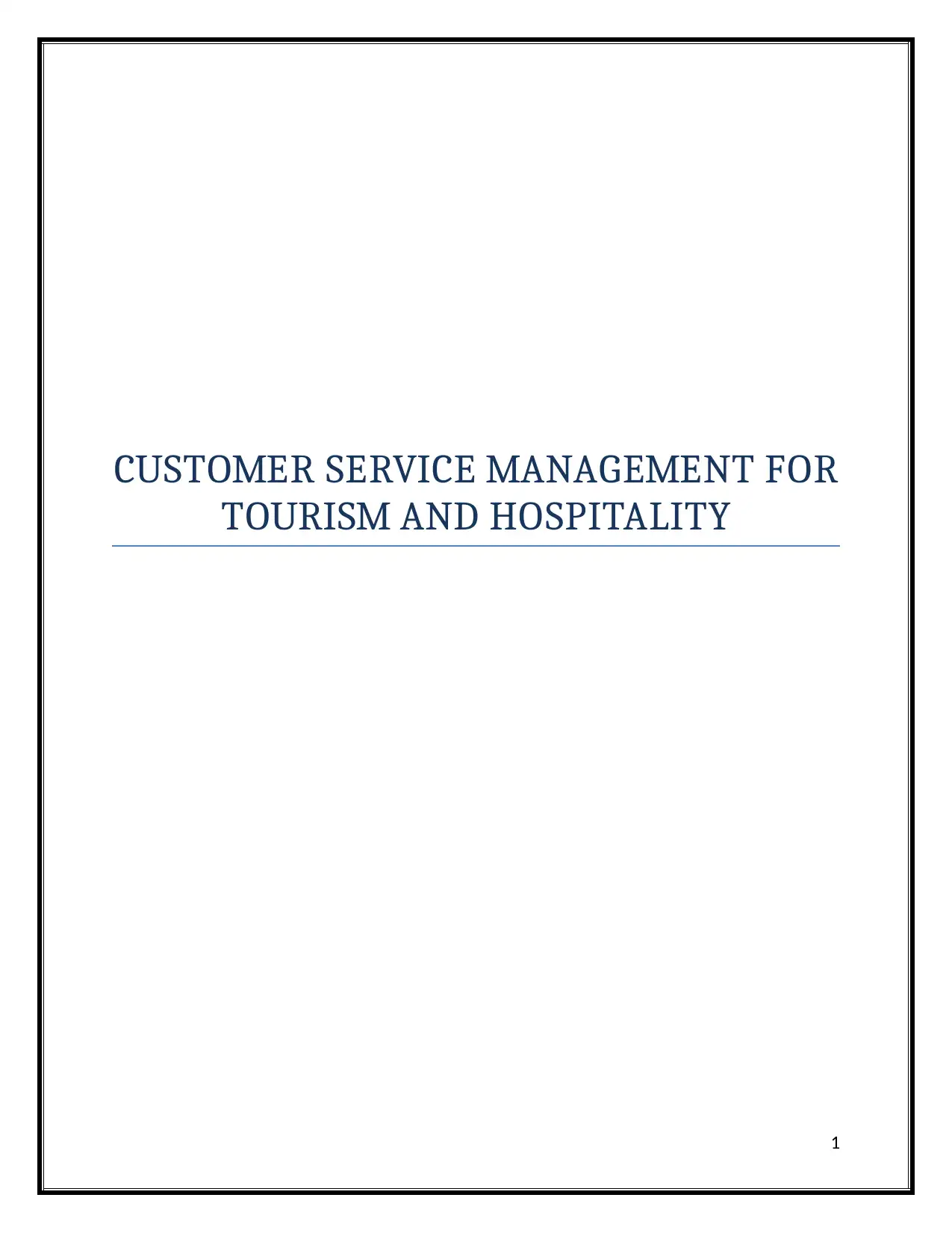
CUSTOMER SERVICE MANAGEMENT FOR
TOURISM AND HOSPITALITY
1
TOURISM AND HOSPITALITY
1
Secure Best Marks with AI Grader
Need help grading? Try our AI Grader for instant feedback on your assignments.

Table of Contents
INTRODUCTION................................................................................................................................3
HOFSTEDE’S MODEL OF CULTURAL DIMENSIONS, IDENTIFY AND EXPLORE THE SIGNIFICANT
DIFFERENCES BETWEEN CHINESE AND BRITISH CONSUMER BEHAVIOUR.....................................4
EVALUATE WHAT CONSIDERATIONS THE EDEN PROJECT MANAGEMENT SHOULD MAKE TO
THEIR MARKETING MIX TO ADJUST TO THE LOCAL CULTURE IN CHINA IN ORDER TO ENHANCE
SERVICE ENCOUNTERS.....................................................................................................................8
CONCLUSION.................................................................................................................................12
REFERENCES...................................................................................................................................13
2
INTRODUCTION................................................................................................................................3
HOFSTEDE’S MODEL OF CULTURAL DIMENSIONS, IDENTIFY AND EXPLORE THE SIGNIFICANT
DIFFERENCES BETWEEN CHINESE AND BRITISH CONSUMER BEHAVIOUR.....................................4
EVALUATE WHAT CONSIDERATIONS THE EDEN PROJECT MANAGEMENT SHOULD MAKE TO
THEIR MARKETING MIX TO ADJUST TO THE LOCAL CULTURE IN CHINA IN ORDER TO ENHANCE
SERVICE ENCOUNTERS.....................................................................................................................8
CONCLUSION.................................................................................................................................12
REFERENCES...................................................................................................................................13
2
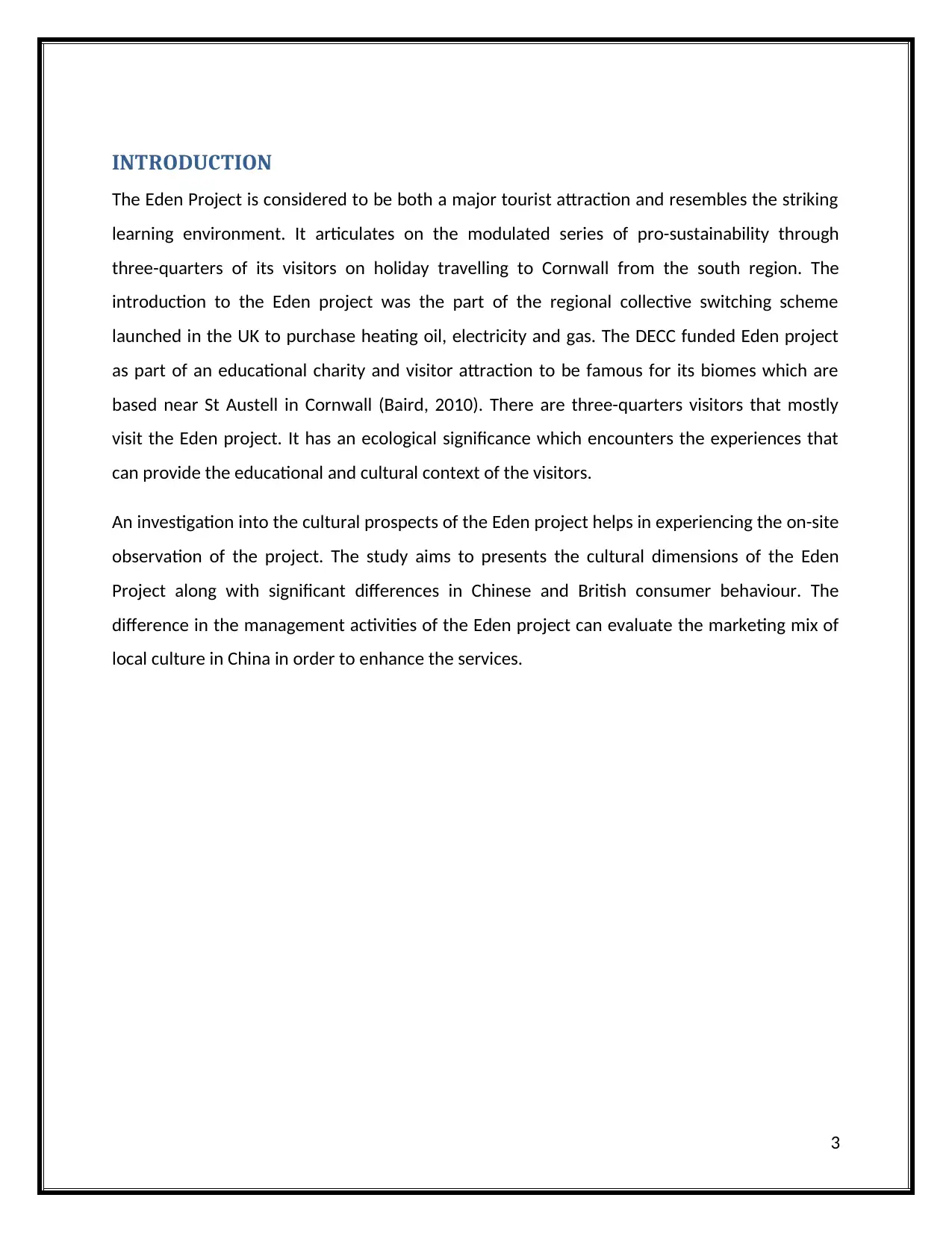
INTRODUCTION
The Eden Project is considered to be both a major tourist attraction and resembles the striking
learning environment. It articulates on the modulated series of pro-sustainability through
three-quarters of its visitors on holiday travelling to Cornwall from the south region. The
introduction to the Eden project was the part of the regional collective switching scheme
launched in the UK to purchase heating oil, electricity and gas. The DECC funded Eden project
as part of an educational charity and visitor attraction to be famous for its biomes which are
based near St Austell in Cornwall (Baird, 2010). There are three-quarters visitors that mostly
visit the Eden project. It has an ecological significance which encounters the experiences that
can provide the educational and cultural context of the visitors.
An investigation into the cultural prospects of the Eden project helps in experiencing the on-site
observation of the project. The study aims to presents the cultural dimensions of the Eden
Project along with significant differences in Chinese and British consumer behaviour. The
difference in the management activities of the Eden project can evaluate the marketing mix of
local culture in China in order to enhance the services.
3
The Eden Project is considered to be both a major tourist attraction and resembles the striking
learning environment. It articulates on the modulated series of pro-sustainability through
three-quarters of its visitors on holiday travelling to Cornwall from the south region. The
introduction to the Eden project was the part of the regional collective switching scheme
launched in the UK to purchase heating oil, electricity and gas. The DECC funded Eden project
as part of an educational charity and visitor attraction to be famous for its biomes which are
based near St Austell in Cornwall (Baird, 2010). There are three-quarters visitors that mostly
visit the Eden project. It has an ecological significance which encounters the experiences that
can provide the educational and cultural context of the visitors.
An investigation into the cultural prospects of the Eden project helps in experiencing the on-site
observation of the project. The study aims to presents the cultural dimensions of the Eden
Project along with significant differences in Chinese and British consumer behaviour. The
difference in the management activities of the Eden project can evaluate the marketing mix of
local culture in China in order to enhance the services.
3
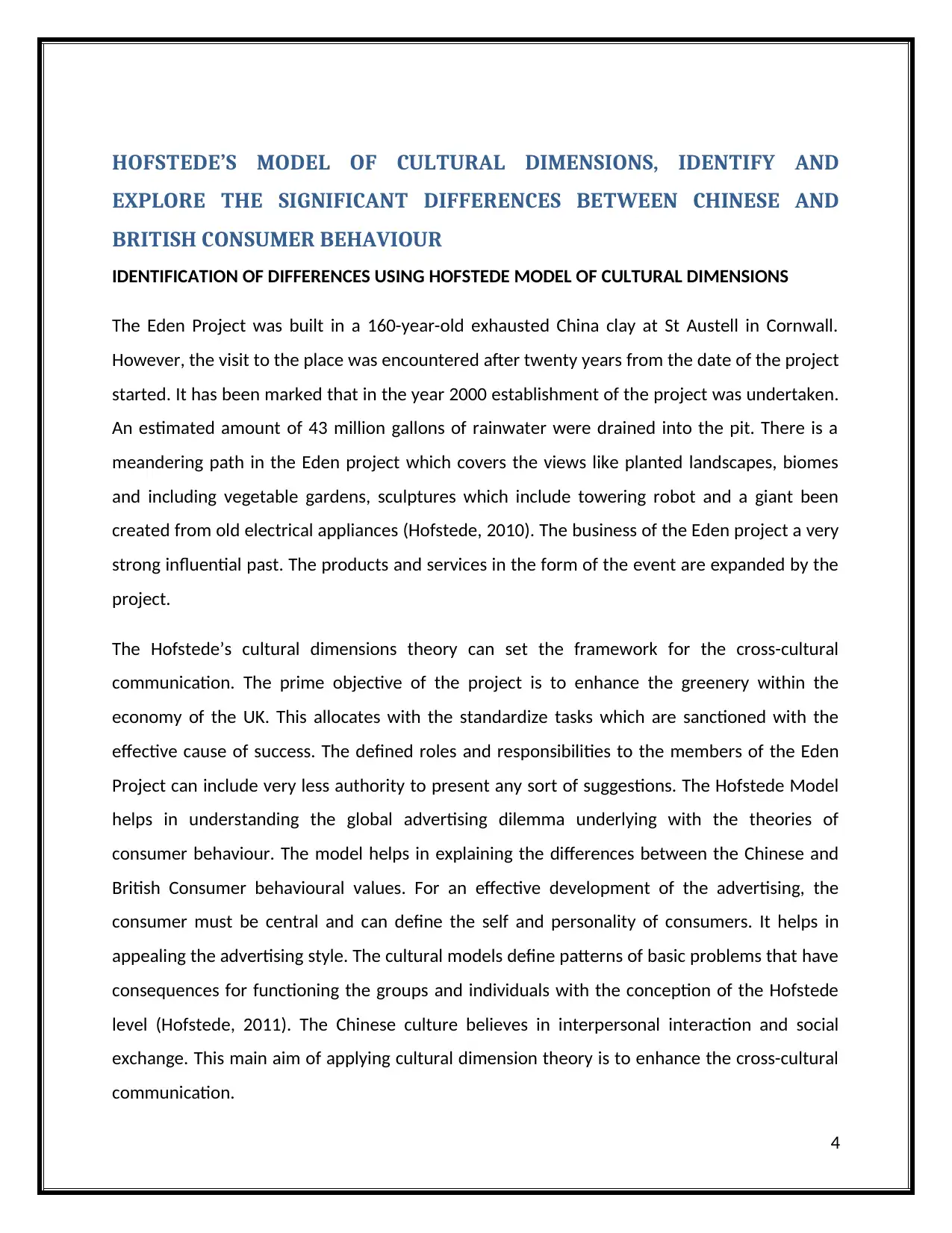
HOFSTEDE’S MODEL OF CULTURAL DIMENSIONS, IDENTIFY AND
EXPLORE THE SIGNIFICANT DIFFERENCES BETWEEN CHINESE AND
BRITISH CONSUMER BEHAVIOUR
IDENTIFICATION OF DIFFERENCES USING HOFSTEDE MODEL OF CULTURAL DIMENSIONS
The Eden Project was built in a 160-year-old exhausted China clay at St Austell in Cornwall.
However, the visit to the place was encountered after twenty years from the date of the project
started. It has been marked that in the year 2000 establishment of the project was undertaken.
An estimated amount of 43 million gallons of rainwater were drained into the pit. There is a
meandering path in the Eden project which covers the views like planted landscapes, biomes
and including vegetable gardens, sculptures which include towering robot and a giant been
created from old electrical appliances (Hofstede, 2010). The business of the Eden project a very
strong influential past. The products and services in the form of the event are expanded by the
project.
The Hofstede’s cultural dimensions theory can set the framework for the cross-cultural
communication. The prime objective of the project is to enhance the greenery within the
economy of the UK. This allocates with the standardize tasks which are sanctioned with the
effective cause of success. The defined roles and responsibilities to the members of the Eden
Project can include very less authority to present any sort of suggestions. The Hofstede Model
helps in understanding the global advertising dilemma underlying with the theories of
consumer behaviour. The model helps in explaining the differences between the Chinese and
British Consumer behavioural values. For an effective development of the advertising, the
consumer must be central and can define the self and personality of consumers. It helps in
appealing the advertising style. The cultural models define patterns of basic problems that have
consequences for functioning the groups and individuals with the conception of the Hofstede
level (Hofstede, 2011). The Chinese culture believes in interpersonal interaction and social
exchange. This main aim of applying cultural dimension theory is to enhance the cross-cultural
communication.
4
EXPLORE THE SIGNIFICANT DIFFERENCES BETWEEN CHINESE AND
BRITISH CONSUMER BEHAVIOUR
IDENTIFICATION OF DIFFERENCES USING HOFSTEDE MODEL OF CULTURAL DIMENSIONS
The Eden Project was built in a 160-year-old exhausted China clay at St Austell in Cornwall.
However, the visit to the place was encountered after twenty years from the date of the project
started. It has been marked that in the year 2000 establishment of the project was undertaken.
An estimated amount of 43 million gallons of rainwater were drained into the pit. There is a
meandering path in the Eden project which covers the views like planted landscapes, biomes
and including vegetable gardens, sculptures which include towering robot and a giant been
created from old electrical appliances (Hofstede, 2010). The business of the Eden project a very
strong influential past. The products and services in the form of the event are expanded by the
project.
The Hofstede’s cultural dimensions theory can set the framework for the cross-cultural
communication. The prime objective of the project is to enhance the greenery within the
economy of the UK. This allocates with the standardize tasks which are sanctioned with the
effective cause of success. The defined roles and responsibilities to the members of the Eden
Project can include very less authority to present any sort of suggestions. The Hofstede Model
helps in understanding the global advertising dilemma underlying with the theories of
consumer behaviour. The model helps in explaining the differences between the Chinese and
British Consumer behavioural values. For an effective development of the advertising, the
consumer must be central and can define the self and personality of consumers. It helps in
appealing the advertising style. The cultural models define patterns of basic problems that have
consequences for functioning the groups and individuals with the conception of the Hofstede
level (Hofstede, 2011). The Chinese culture believes in interpersonal interaction and social
exchange. This main aim of applying cultural dimension theory is to enhance the cross-cultural
communication.
4
Secure Best Marks with AI Grader
Need help grading? Try our AI Grader for instant feedback on your assignments.

The Eden project also believes in educational charity and aims to connect people with each
other and the living world. There are many programmes that are associated with Eden project
every time they visit. There is strong narrative with most events which are included in the ticket
price. The Live events like- Male Voice Choral Festival, The Great Eden Easter Egg Hunt, Strange
Science marketing poster artwork can help in featuring the dinosaurs and the visitors with them
(Hofstede, 2011). The cultural differences and its influence have been collective renewed with
the ethnic group. This has been projected with the following:
The groups of people belonging to China and British have a different level of collectivism. This
can be detected on the basis of the loyalty listed in one culture. The 53.8% of the Chinese
respondents have believed that the community those who visit the place hold them with their
religion and collective identity. While the British people, they visit the place in the significance
of the learning many activities. The Chinese in Cornwall tend to remain loyal with the
immediate family and concerned with the propagated importance with the natural
environment.
The Chinese also seems to show the tendency of the uncertainty avoidance. This has adhered
to the group norms in order to protect one face. The greater tolerance for ambiguity and risk
can be perceived as the risk of brand loyalty (Treseder, et al. 2011). The situations that seemed
to face by the group norms at the time of resulting in more image consciousness among the
Chinese may have a lower level of uncertainty for the Eden Project. Thus, the cultural
dimensions of the British and Chinese can triggers with show no significant difference in
individualism/collectivism was propounded. This has made differences in the masculinity and
power distance. The groups that are visiting the place belong to different culture, task and
brand loyalty.
There were preliminary ideas which have explained the lack of understanding and how
standardization and adaption can play a significant role in international markets. The issues that
were encountered in the launch of the Project are diverse. The two biomes are plants that
control the climatic environment (Reed, 2017). The team conceived by Tim Smit and Nicholas
Grimshaw can associate with the services, environment and another measure. The project took
5
other and the living world. There are many programmes that are associated with Eden project
every time they visit. There is strong narrative with most events which are included in the ticket
price. The Live events like- Male Voice Choral Festival, The Great Eden Easter Egg Hunt, Strange
Science marketing poster artwork can help in featuring the dinosaurs and the visitors with them
(Hofstede, 2011). The cultural differences and its influence have been collective renewed with
the ethnic group. This has been projected with the following:
The groups of people belonging to China and British have a different level of collectivism. This
can be detected on the basis of the loyalty listed in one culture. The 53.8% of the Chinese
respondents have believed that the community those who visit the place hold them with their
religion and collective identity. While the British people, they visit the place in the significance
of the learning many activities. The Chinese in Cornwall tend to remain loyal with the
immediate family and concerned with the propagated importance with the natural
environment.
The Chinese also seems to show the tendency of the uncertainty avoidance. This has adhered
to the group norms in order to protect one face. The greater tolerance for ambiguity and risk
can be perceived as the risk of brand loyalty (Treseder, et al. 2011). The situations that seemed
to face by the group norms at the time of resulting in more image consciousness among the
Chinese may have a lower level of uncertainty for the Eden Project. Thus, the cultural
dimensions of the British and Chinese can triggers with show no significant difference in
individualism/collectivism was propounded. This has made differences in the masculinity and
power distance. The groups that are visiting the place belong to different culture, task and
brand loyalty.
There were preliminary ideas which have explained the lack of understanding and how
standardization and adaption can play a significant role in international markets. The issues that
were encountered in the launch of the Project are diverse. The two biomes are plants that
control the climatic environment (Reed, 2017). The team conceived by Tim Smit and Nicholas
Grimshaw can associate with the services, environment and another measure. The project took
5
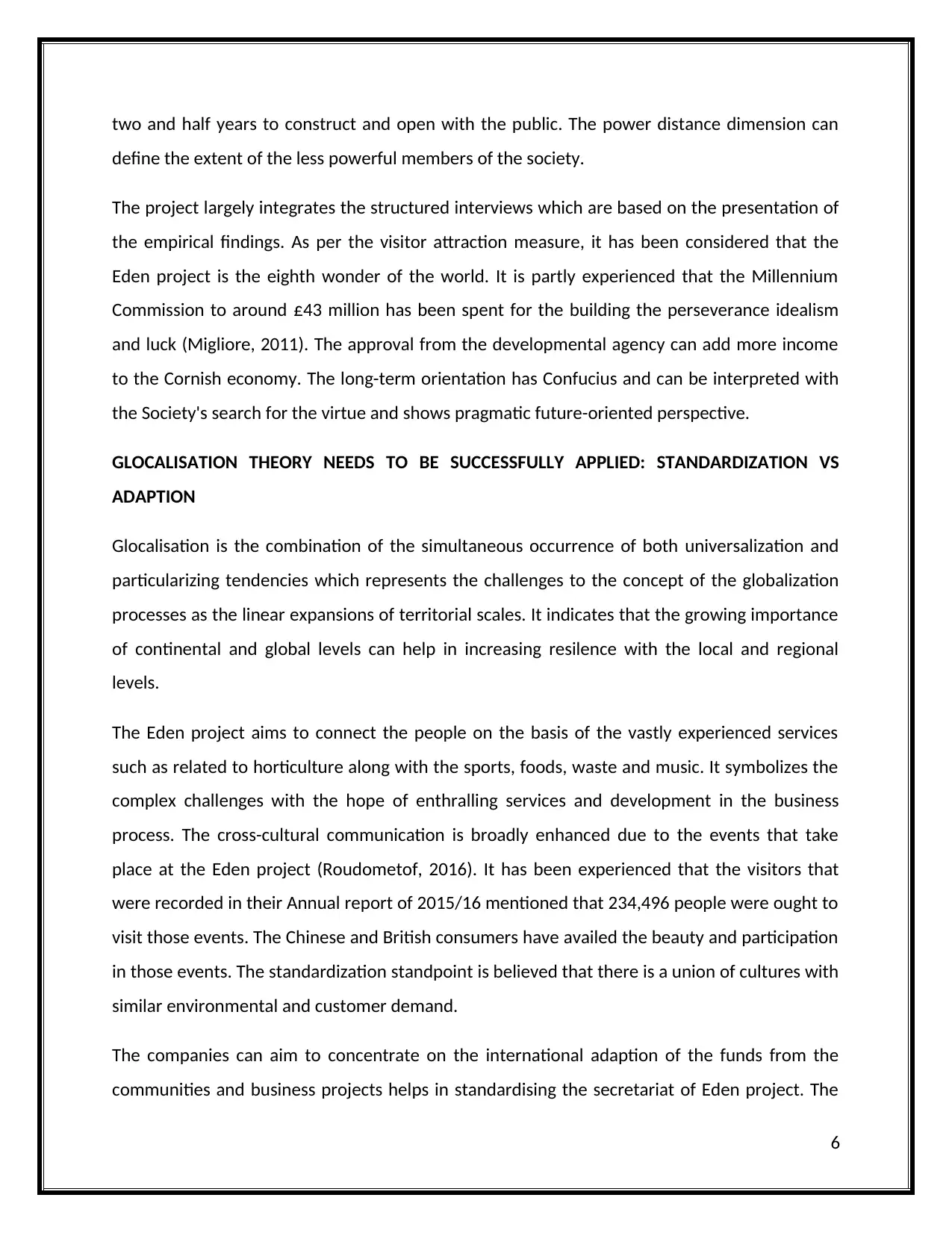
two and half years to construct and open with the public. The power distance dimension can
define the extent of the less powerful members of the society.
The project largely integrates the structured interviews which are based on the presentation of
the empirical findings. As per the visitor attraction measure, it has been considered that the
Eden project is the eighth wonder of the world. It is partly experienced that the Millennium
Commission to around £43 million has been spent for the building the perseverance idealism
and luck (Migliore, 2011). The approval from the developmental agency can add more income
to the Cornish economy. The long-term orientation has Confucius and can be interpreted with
the Society's search for the virtue and shows pragmatic future-oriented perspective.
GLOCALISATION THEORY NEEDS TO BE SUCCESSFULLY APPLIED: STANDARDIZATION VS
ADAPTION
Glocalisation is the combination of the simultaneous occurrence of both universalization and
particularizing tendencies which represents the challenges to the concept of the globalization
processes as the linear expansions of territorial scales. It indicates that the growing importance
of continental and global levels can help in increasing resilence with the local and regional
levels.
The Eden project aims to connect the people on the basis of the vastly experienced services
such as related to horticulture along with the sports, foods, waste and music. It symbolizes the
complex challenges with the hope of enthralling services and development in the business
process. The cross-cultural communication is broadly enhanced due to the events that take
place at the Eden project (Roudometof, 2016). It has been experienced that the visitors that
were recorded in their Annual report of 2015/16 mentioned that 234,496 people were ought to
visit those events. The Chinese and British consumers have availed the beauty and participation
in those events. The standardization standpoint is believed that there is a union of cultures with
similar environmental and customer demand.
The companies can aim to concentrate on the international adaption of the funds from the
communities and business projects helps in standardising the secretariat of Eden project. The
6
define the extent of the less powerful members of the society.
The project largely integrates the structured interviews which are based on the presentation of
the empirical findings. As per the visitor attraction measure, it has been considered that the
Eden project is the eighth wonder of the world. It is partly experienced that the Millennium
Commission to around £43 million has been spent for the building the perseverance idealism
and luck (Migliore, 2011). The approval from the developmental agency can add more income
to the Cornish economy. The long-term orientation has Confucius and can be interpreted with
the Society's search for the virtue and shows pragmatic future-oriented perspective.
GLOCALISATION THEORY NEEDS TO BE SUCCESSFULLY APPLIED: STANDARDIZATION VS
ADAPTION
Glocalisation is the combination of the simultaneous occurrence of both universalization and
particularizing tendencies which represents the challenges to the concept of the globalization
processes as the linear expansions of territorial scales. It indicates that the growing importance
of continental and global levels can help in increasing resilence with the local and regional
levels.
The Eden project aims to connect the people on the basis of the vastly experienced services
such as related to horticulture along with the sports, foods, waste and music. It symbolizes the
complex challenges with the hope of enthralling services and development in the business
process. The cross-cultural communication is broadly enhanced due to the events that take
place at the Eden project (Roudometof, 2016). It has been experienced that the visitors that
were recorded in their Annual report of 2015/16 mentioned that 234,496 people were ought to
visit those events. The Chinese and British consumers have availed the beauty and participation
in those events. The standardization standpoint is believed that there is a union of cultures with
similar environmental and customer demand.
The companies can aim to concentrate on the international adaption of the funds from the
communities and business projects helps in standardising the secretariat of Eden project. The
6
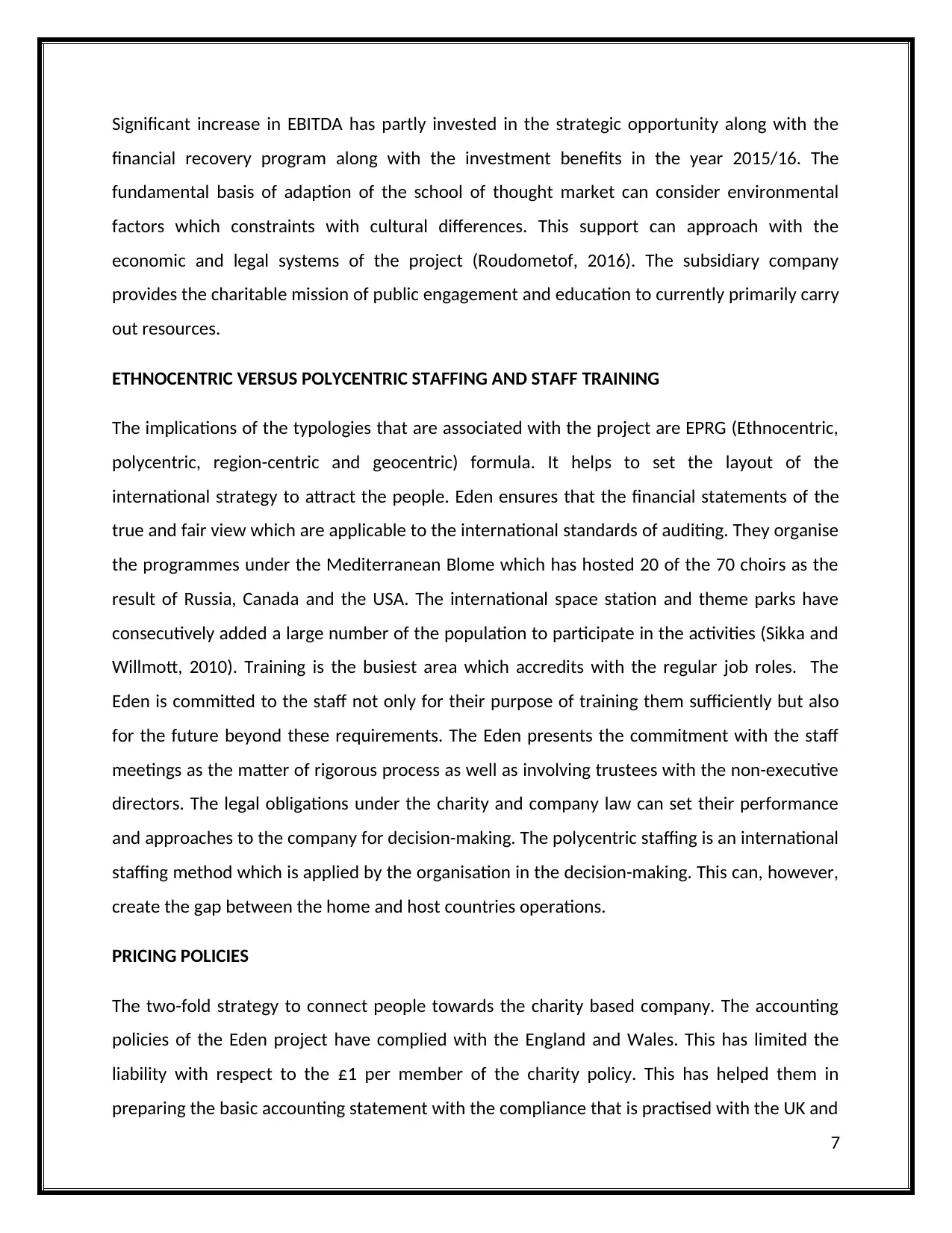
Significant increase in EBITDA has partly invested in the strategic opportunity along with the
financial recovery program along with the investment benefits in the year 2015/16. The
fundamental basis of adaption of the school of thought market can consider environmental
factors which constraints with cultural differences. This support can approach with the
economic and legal systems of the project (Roudometof, 2016). The subsidiary company
provides the charitable mission of public engagement and education to currently primarily carry
out resources.
ETHNOCENTRIC VERSUS POLYCENTRIC STAFFING AND STAFF TRAINING
The implications of the typologies that are associated with the project are EPRG (Ethnocentric,
polycentric, region-centric and geocentric) formula. It helps to set the layout of the
international strategy to attract the people. Eden ensures that the financial statements of the
true and fair view which are applicable to the international standards of auditing. They organise
the programmes under the Mediterranean Blome which has hosted 20 of the 70 choirs as the
result of Russia, Canada and the USA. The international space station and theme parks have
consecutively added a large number of the population to participate in the activities (Sikka and
Willmott, 2010). Training is the busiest area which accredits with the regular job roles. The
Eden is committed to the staff not only for their purpose of training them sufficiently but also
for the future beyond these requirements. The Eden presents the commitment with the staff
meetings as the matter of rigorous process as well as involving trustees with the non-executive
directors. The legal obligations under the charity and company law can set their performance
and approaches to the company for decision-making. The polycentric staffing is an international
staffing method which is applied by the organisation in the decision-making. This can, however,
create the gap between the home and host countries operations.
PRICING POLICIES
The two-fold strategy to connect people towards the charity based company. The accounting
policies of the Eden project have complied with the England and Wales. This has limited the
liability with respect to the £1 per member of the charity policy. This has helped them in
preparing the basic accounting statement with the compliance that is practised with the UK and
7
financial recovery program along with the investment benefits in the year 2015/16. The
fundamental basis of adaption of the school of thought market can consider environmental
factors which constraints with cultural differences. This support can approach with the
economic and legal systems of the project (Roudometof, 2016). The subsidiary company
provides the charitable mission of public engagement and education to currently primarily carry
out resources.
ETHNOCENTRIC VERSUS POLYCENTRIC STAFFING AND STAFF TRAINING
The implications of the typologies that are associated with the project are EPRG (Ethnocentric,
polycentric, region-centric and geocentric) formula. It helps to set the layout of the
international strategy to attract the people. Eden ensures that the financial statements of the
true and fair view which are applicable to the international standards of auditing. They organise
the programmes under the Mediterranean Blome which has hosted 20 of the 70 choirs as the
result of Russia, Canada and the USA. The international space station and theme parks have
consecutively added a large number of the population to participate in the activities (Sikka and
Willmott, 2010). Training is the busiest area which accredits with the regular job roles. The
Eden is committed to the staff not only for their purpose of training them sufficiently but also
for the future beyond these requirements. The Eden presents the commitment with the staff
meetings as the matter of rigorous process as well as involving trustees with the non-executive
directors. The legal obligations under the charity and company law can set their performance
and approaches to the company for decision-making. The polycentric staffing is an international
staffing method which is applied by the organisation in the decision-making. This can, however,
create the gap between the home and host countries operations.
PRICING POLICIES
The two-fold strategy to connect people towards the charity based company. The accounting
policies of the Eden project have complied with the England and Wales. This has limited the
liability with respect to the £1 per member of the charity policy. This has helped them in
preparing the basic accounting statement with the compliance that is practised with the UK and
7
Paraphrase This Document
Need a fresh take? Get an instant paraphrase of this document with our AI Paraphraser
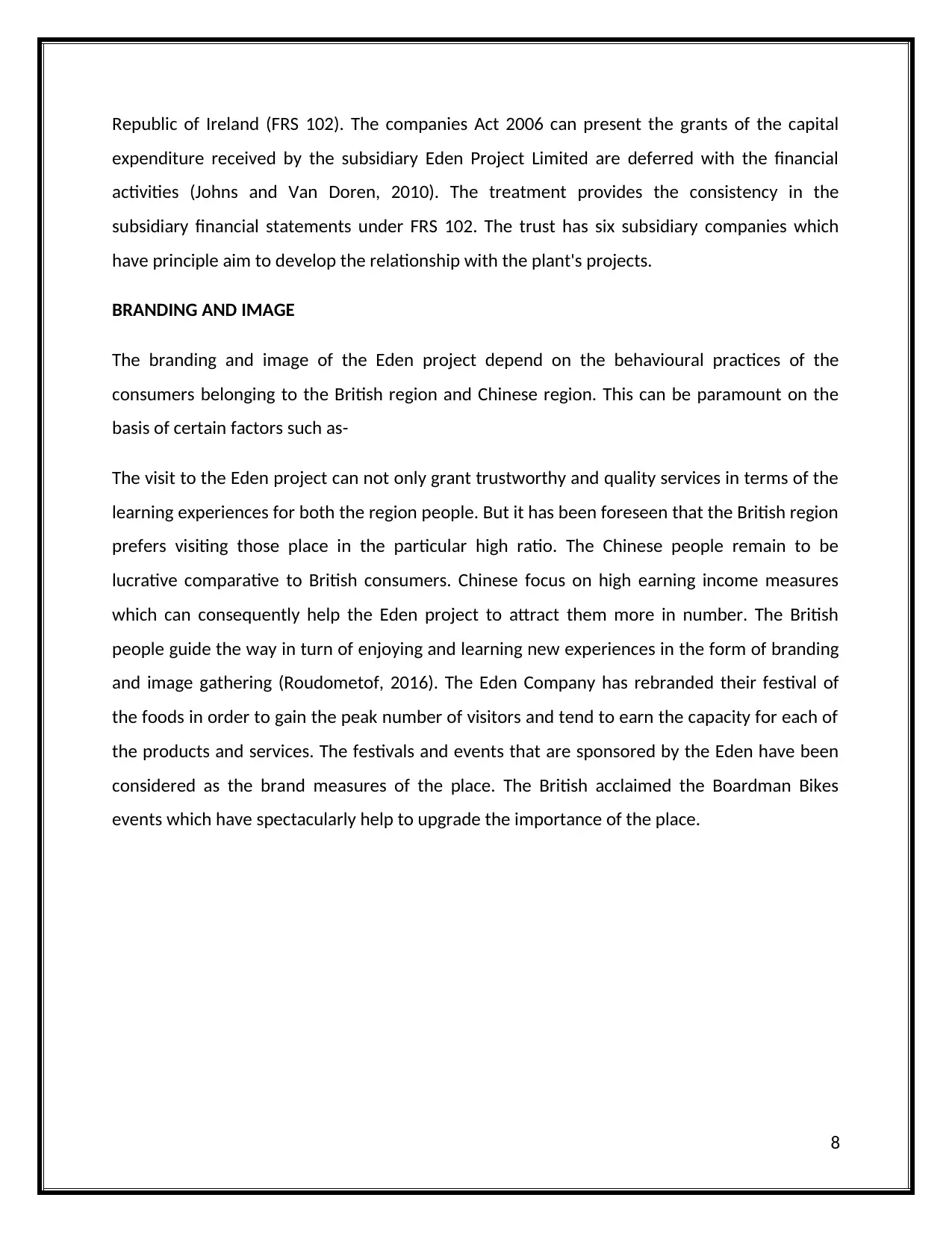
Republic of Ireland (FRS 102). The companies Act 2006 can present the grants of the capital
expenditure received by the subsidiary Eden Project Limited are deferred with the financial
activities (Johns and Van Doren, 2010). The treatment provides the consistency in the
subsidiary financial statements under FRS 102. The trust has six subsidiary companies which
have principle aim to develop the relationship with the plant's projects.
BRANDING AND IMAGE
The branding and image of the Eden project depend on the behavioural practices of the
consumers belonging to the British region and Chinese region. This can be paramount on the
basis of certain factors such as-
The visit to the Eden project can not only grant trustworthy and quality services in terms of the
learning experiences for both the region people. But it has been foreseen that the British region
prefers visiting those place in the particular high ratio. The Chinese people remain to be
lucrative comparative to British consumers. Chinese focus on high earning income measures
which can consequently help the Eden project to attract them more in number. The British
people guide the way in turn of enjoying and learning new experiences in the form of branding
and image gathering (Roudometof, 2016). The Eden Company has rebranded their festival of
the foods in order to gain the peak number of visitors and tend to earn the capacity for each of
the products and services. The festivals and events that are sponsored by the Eden have been
considered as the brand measures of the place. The British acclaimed the Boardman Bikes
events which have spectacularly help to upgrade the importance of the place.
8
expenditure received by the subsidiary Eden Project Limited are deferred with the financial
activities (Johns and Van Doren, 2010). The treatment provides the consistency in the
subsidiary financial statements under FRS 102. The trust has six subsidiary companies which
have principle aim to develop the relationship with the plant's projects.
BRANDING AND IMAGE
The branding and image of the Eden project depend on the behavioural practices of the
consumers belonging to the British region and Chinese region. This can be paramount on the
basis of certain factors such as-
The visit to the Eden project can not only grant trustworthy and quality services in terms of the
learning experiences for both the region people. But it has been foreseen that the British region
prefers visiting those place in the particular high ratio. The Chinese people remain to be
lucrative comparative to British consumers. Chinese focus on high earning income measures
which can consequently help the Eden project to attract them more in number. The British
people guide the way in turn of enjoying and learning new experiences in the form of branding
and image gathering (Roudometof, 2016). The Eden Company has rebranded their festival of
the foods in order to gain the peak number of visitors and tend to earn the capacity for each of
the products and services. The festivals and events that are sponsored by the Eden have been
considered as the brand measures of the place. The British acclaimed the Boardman Bikes
events which have spectacularly help to upgrade the importance of the place.
8
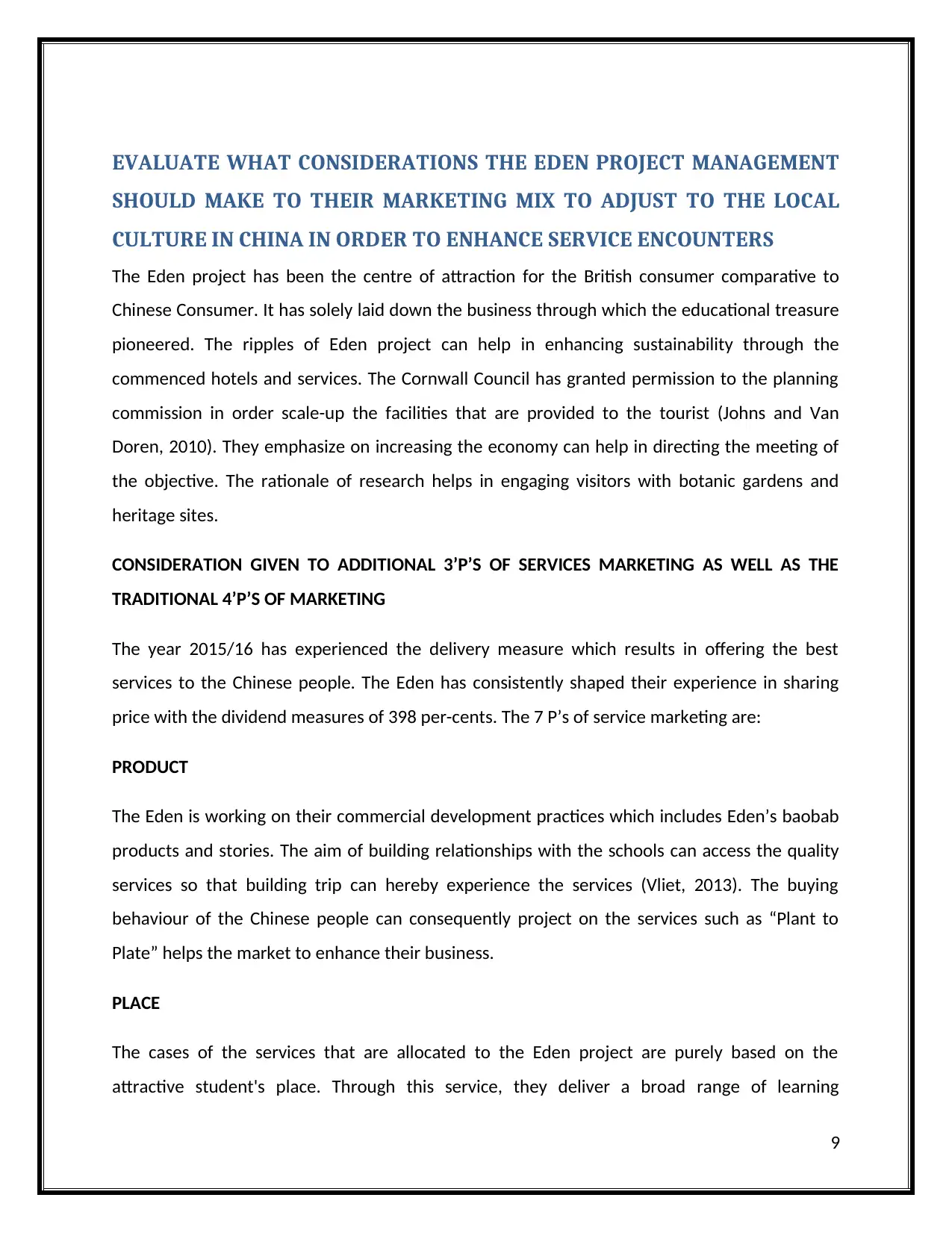
EVALUATE WHAT CONSIDERATIONS THE EDEN PROJECT MANAGEMENT
SHOULD MAKE TO THEIR MARKETING MIX TO ADJUST TO THE LOCAL
CULTURE IN CHINA IN ORDER TO ENHANCE SERVICE ENCOUNTERS
The Eden project has been the centre of attraction for the British consumer comparative to
Chinese Consumer. It has solely laid down the business through which the educational treasure
pioneered. The ripples of Eden project can help in enhancing sustainability through the
commenced hotels and services. The Cornwall Council has granted permission to the planning
commission in order scale-up the facilities that are provided to the tourist (Johns and Van
Doren, 2010). They emphasize on increasing the economy can help in directing the meeting of
the objective. The rationale of research helps in engaging visitors with botanic gardens and
heritage sites.
CONSIDERATION GIVEN TO ADDITIONAL 3’P’S OF SERVICES MARKETING AS WELL AS THE
TRADITIONAL 4’P’S OF MARKETING
The year 2015/16 has experienced the delivery measure which results in offering the best
services to the Chinese people. The Eden has consistently shaped their experience in sharing
price with the dividend measures of 398 per-cents. The 7 P’s of service marketing are:
PRODUCT
The Eden is working on their commercial development practices which includes Eden’s baobab
products and stories. The aim of building relationships with the schools can access the quality
services so that building trip can hereby experience the services (Vliet, 2013). The buying
behaviour of the Chinese people can consequently project on the services such as “Plant to
Plate” helps the market to enhance their business.
PLACE
The cases of the services that are allocated to the Eden project are purely based on the
attractive student's place. Through this service, they deliver a broad range of learning
9
SHOULD MAKE TO THEIR MARKETING MIX TO ADJUST TO THE LOCAL
CULTURE IN CHINA IN ORDER TO ENHANCE SERVICE ENCOUNTERS
The Eden project has been the centre of attraction for the British consumer comparative to
Chinese Consumer. It has solely laid down the business through which the educational treasure
pioneered. The ripples of Eden project can help in enhancing sustainability through the
commenced hotels and services. The Cornwall Council has granted permission to the planning
commission in order scale-up the facilities that are provided to the tourist (Johns and Van
Doren, 2010). They emphasize on increasing the economy can help in directing the meeting of
the objective. The rationale of research helps in engaging visitors with botanic gardens and
heritage sites.
CONSIDERATION GIVEN TO ADDITIONAL 3’P’S OF SERVICES MARKETING AS WELL AS THE
TRADITIONAL 4’P’S OF MARKETING
The year 2015/16 has experienced the delivery measure which results in offering the best
services to the Chinese people. The Eden has consistently shaped their experience in sharing
price with the dividend measures of 398 per-cents. The 7 P’s of service marketing are:
PRODUCT
The Eden is working on their commercial development practices which includes Eden’s baobab
products and stories. The aim of building relationships with the schools can access the quality
services so that building trip can hereby experience the services (Vliet, 2013). The buying
behaviour of the Chinese people can consequently project on the services such as “Plant to
Plate” helps the market to enhance their business.
PLACE
The cases of the services that are allocated to the Eden project are purely based on the
attractive student's place. Through this service, they deliver a broad range of learning
9
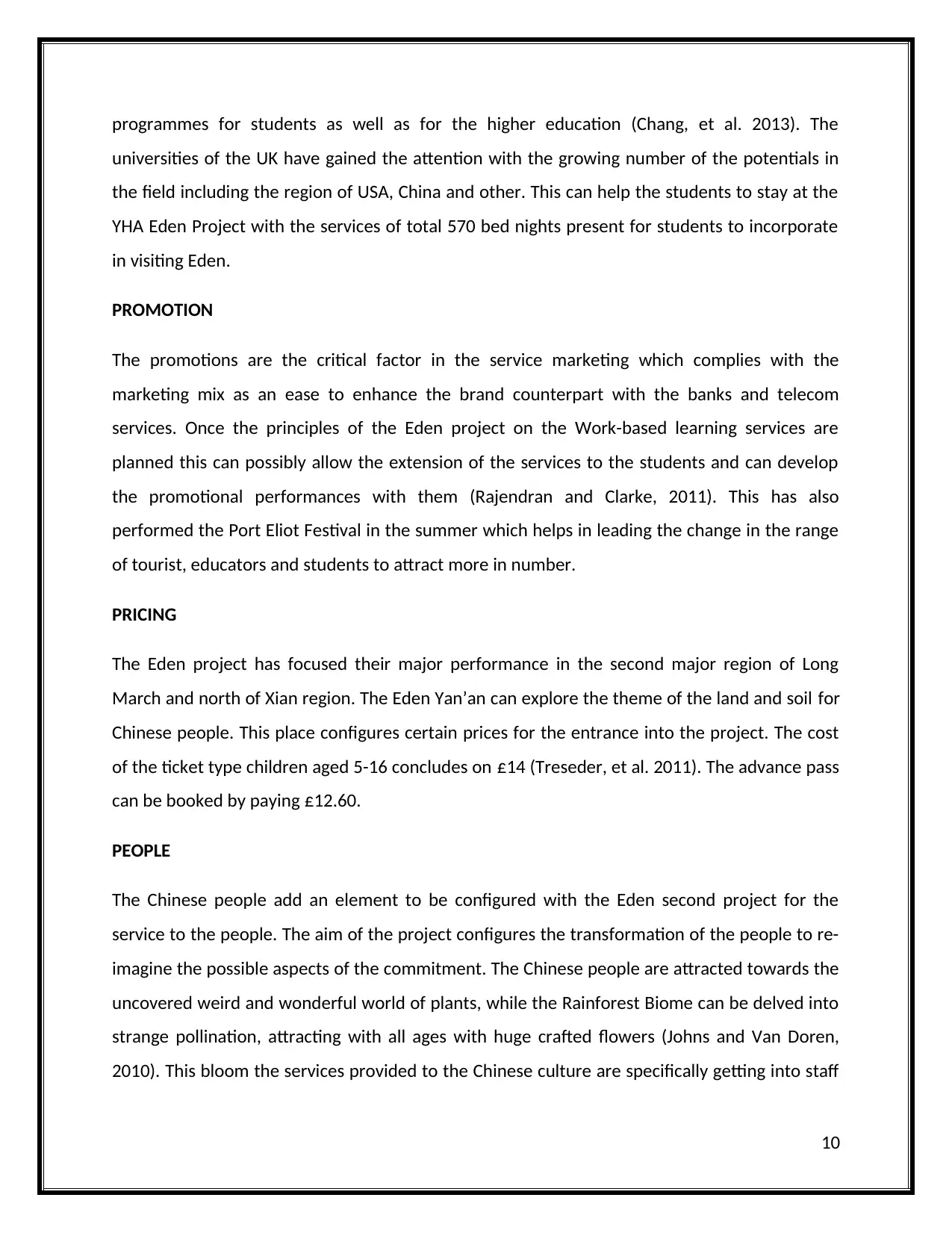
programmes for students as well as for the higher education (Chang, et al. 2013). The
universities of the UK have gained the attention with the growing number of the potentials in
the field including the region of USA, China and other. This can help the students to stay at the
YHA Eden Project with the services of total 570 bed nights present for students to incorporate
in visiting Eden.
PROMOTION
The promotions are the critical factor in the service marketing which complies with the
marketing mix as an ease to enhance the brand counterpart with the banks and telecom
services. Once the principles of the Eden project on the Work-based learning services are
planned this can possibly allow the extension of the services to the students and can develop
the promotional performances with them (Rajendran and Clarke, 2011). This has also
performed the Port Eliot Festival in the summer which helps in leading the change in the range
of tourist, educators and students to attract more in number.
PRICING
The Eden project has focused their major performance in the second major region of Long
March and north of Xian region. The Eden Yan’an can explore the theme of the land and soil for
Chinese people. This place configures certain prices for the entrance into the project. The cost
of the ticket type children aged 5-16 concludes on £14 (Treseder, et al. 2011). The advance pass
can be booked by paying £12.60.
PEOPLE
The Chinese people add an element to be configured with the Eden second project for the
service to the people. The aim of the project configures the transformation of the people to re-
imagine the possible aspects of the commitment. The Chinese people are attracted towards the
uncovered weird and wonderful world of plants, while the Rainforest Biome can be delved into
strange pollination, attracting with all ages with huge crafted flowers (Johns and Van Doren,
2010). This bloom the services provided to the Chinese culture are specifically getting into staff
10
universities of the UK have gained the attention with the growing number of the potentials in
the field including the region of USA, China and other. This can help the students to stay at the
YHA Eden Project with the services of total 570 bed nights present for students to incorporate
in visiting Eden.
PROMOTION
The promotions are the critical factor in the service marketing which complies with the
marketing mix as an ease to enhance the brand counterpart with the banks and telecom
services. Once the principles of the Eden project on the Work-based learning services are
planned this can possibly allow the extension of the services to the students and can develop
the promotional performances with them (Rajendran and Clarke, 2011). This has also
performed the Port Eliot Festival in the summer which helps in leading the change in the range
of tourist, educators and students to attract more in number.
PRICING
The Eden project has focused their major performance in the second major region of Long
March and north of Xian region. The Eden Yan’an can explore the theme of the land and soil for
Chinese people. This place configures certain prices for the entrance into the project. The cost
of the ticket type children aged 5-16 concludes on £14 (Treseder, et al. 2011). The advance pass
can be booked by paying £12.60.
PEOPLE
The Chinese people add an element to be configured with the Eden second project for the
service to the people. The aim of the project configures the transformation of the people to re-
imagine the possible aspects of the commitment. The Chinese people are attracted towards the
uncovered weird and wonderful world of plants, while the Rainforest Biome can be delved into
strange pollination, attracting with all ages with huge crafted flowers (Johns and Van Doren,
2010). This bloom the services provided to the Chinese culture are specifically getting into staff
10
Secure Best Marks with AI Grader
Need help grading? Try our AI Grader for instant feedback on your assignments.
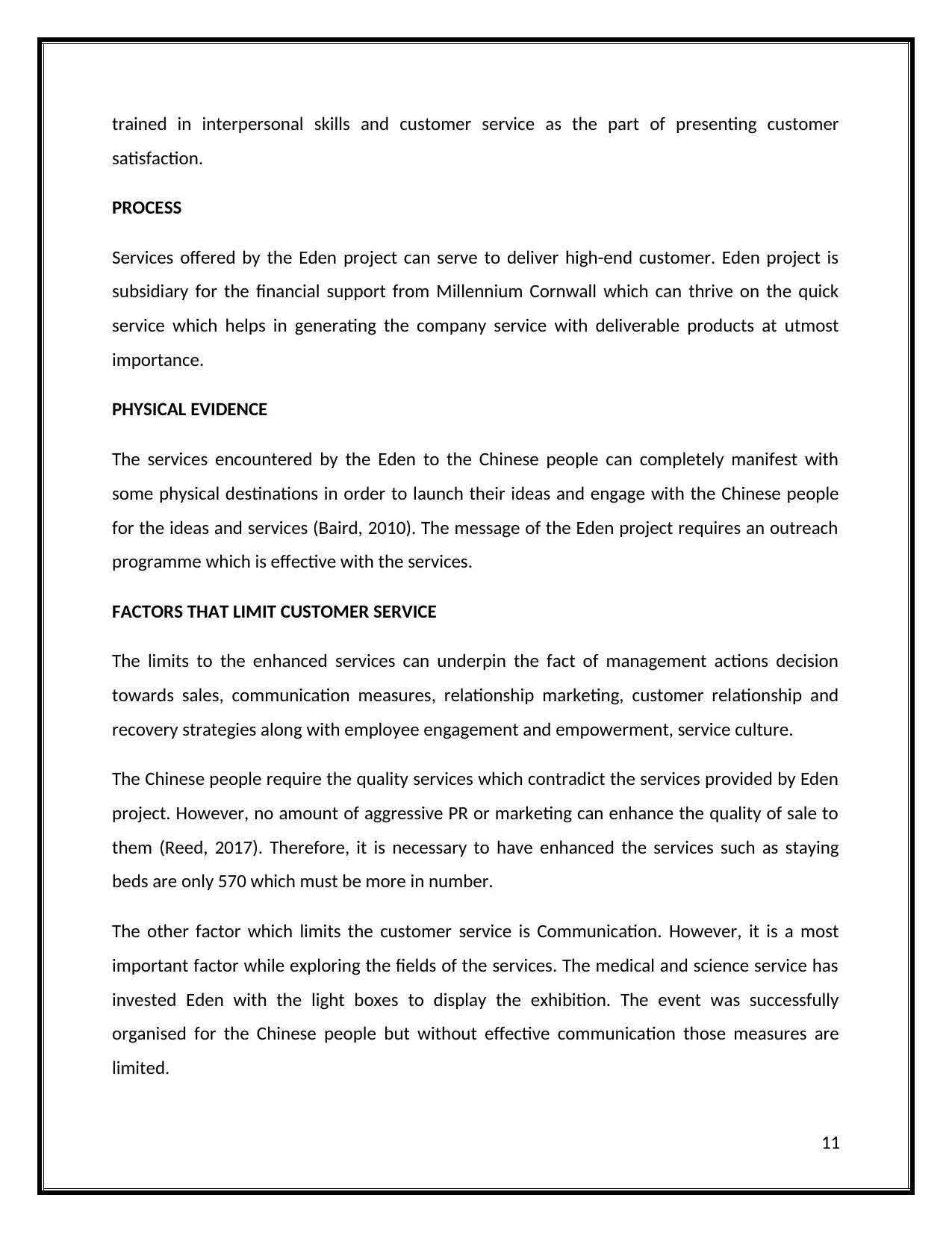
trained in interpersonal skills and customer service as the part of presenting customer
satisfaction.
PROCESS
Services offered by the Eden project can serve to deliver high-end customer. Eden project is
subsidiary for the financial support from Millennium Cornwall which can thrive on the quick
service which helps in generating the company service with deliverable products at utmost
importance.
PHYSICAL EVIDENCE
The services encountered by the Eden to the Chinese people can completely manifest with
some physical destinations in order to launch their ideas and engage with the Chinese people
for the ideas and services (Baird, 2010). The message of the Eden project requires an outreach
programme which is effective with the services.
FACTORS THAT LIMIT CUSTOMER SERVICE
The limits to the enhanced services can underpin the fact of management actions decision
towards sales, communication measures, relationship marketing, customer relationship and
recovery strategies along with employee engagement and empowerment, service culture.
The Chinese people require the quality services which contradict the services provided by Eden
project. However, no amount of aggressive PR or marketing can enhance the quality of sale to
them (Reed, 2017). Therefore, it is necessary to have enhanced the services such as staying
beds are only 570 which must be more in number.
The other factor which limits the customer service is Communication. However, it is a most
important factor while exploring the fields of the services. The medical and science service has
invested Eden with the light boxes to display the exhibition. The event was successfully
organised for the Chinese people but without effective communication those measures are
limited.
11
satisfaction.
PROCESS
Services offered by the Eden project can serve to deliver high-end customer. Eden project is
subsidiary for the financial support from Millennium Cornwall which can thrive on the quick
service which helps in generating the company service with deliverable products at utmost
importance.
PHYSICAL EVIDENCE
The services encountered by the Eden to the Chinese people can completely manifest with
some physical destinations in order to launch their ideas and engage with the Chinese people
for the ideas and services (Baird, 2010). The message of the Eden project requires an outreach
programme which is effective with the services.
FACTORS THAT LIMIT CUSTOMER SERVICE
The limits to the enhanced services can underpin the fact of management actions decision
towards sales, communication measures, relationship marketing, customer relationship and
recovery strategies along with employee engagement and empowerment, service culture.
The Chinese people require the quality services which contradict the services provided by Eden
project. However, no amount of aggressive PR or marketing can enhance the quality of sale to
them (Reed, 2017). Therefore, it is necessary to have enhanced the services such as staying
beds are only 570 which must be more in number.
The other factor which limits the customer service is Communication. However, it is a most
important factor while exploring the fields of the services. The medical and science service has
invested Eden with the light boxes to display the exhibition. The event was successfully
organised for the Chinese people but without effective communication those measures are
limited.
11
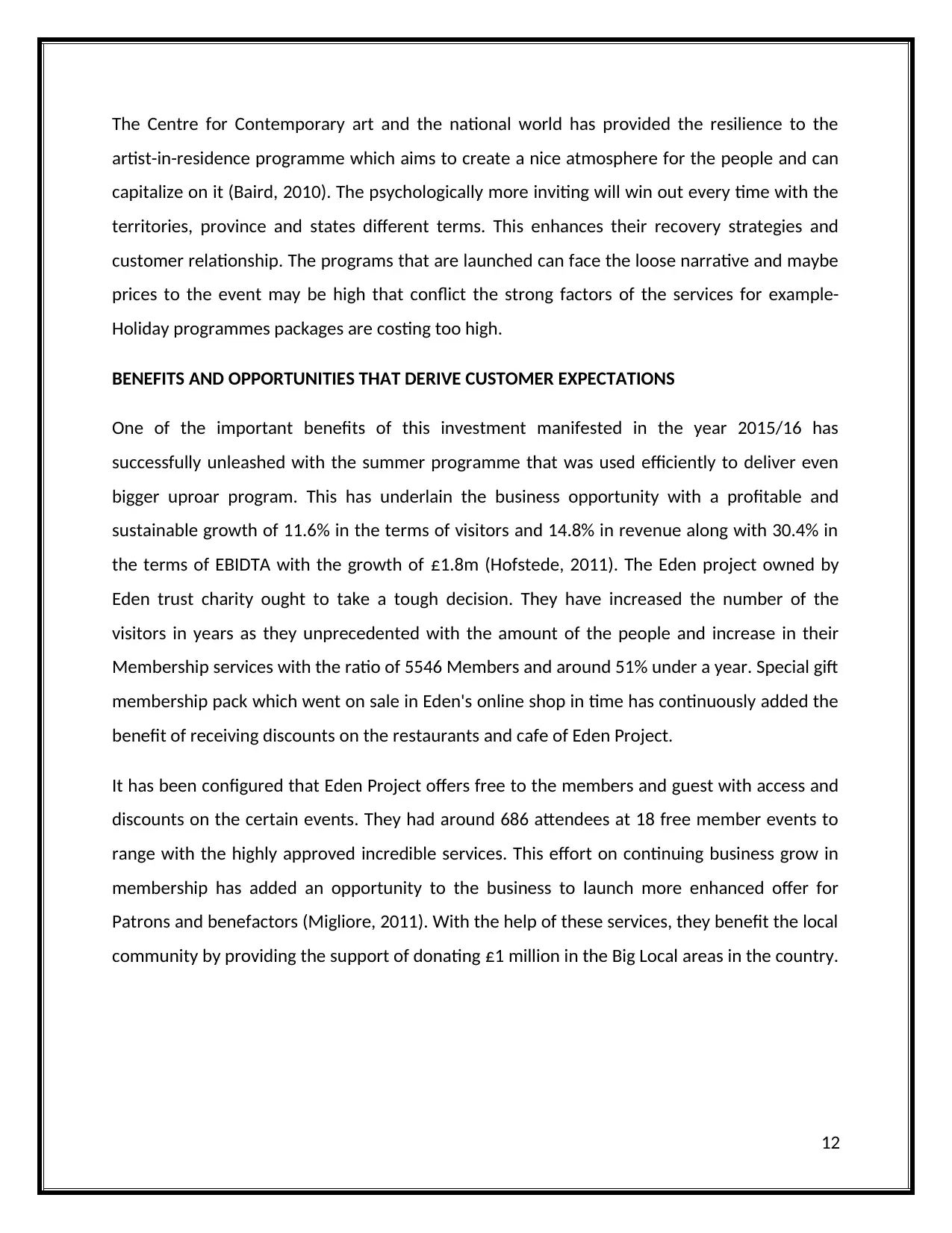
The Centre for Contemporary art and the national world has provided the resilience to the
artist-in-residence programme which aims to create a nice atmosphere for the people and can
capitalize on it (Baird, 2010). The psychologically more inviting will win out every time with the
territories, province and states different terms. This enhances their recovery strategies and
customer relationship. The programs that are launched can face the loose narrative and maybe
prices to the event may be high that conflict the strong factors of the services for example-
Holiday programmes packages are costing too high.
BENEFITS AND OPPORTUNITIES THAT DERIVE CUSTOMER EXPECTATIONS
One of the important benefits of this investment manifested in the year 2015/16 has
successfully unleashed with the summer programme that was used efficiently to deliver even
bigger uproar program. This has underlain the business opportunity with a profitable and
sustainable growth of 11.6% in the terms of visitors and 14.8% in revenue along with 30.4% in
the terms of EBIDTA with the growth of £1.8m (Hofstede, 2011). The Eden project owned by
Eden trust charity ought to take a tough decision. They have increased the number of the
visitors in years as they unprecedented with the amount of the people and increase in their
Membership services with the ratio of 5546 Members and around 51% under a year. Special gift
membership pack which went on sale in Eden's online shop in time has continuously added the
benefit of receiving discounts on the restaurants and cafe of Eden Project.
It has been configured that Eden Project offers free to the members and guest with access and
discounts on the certain events. They had around 686 attendees at 18 free member events to
range with the highly approved incredible services. This effort on continuing business grow in
membership has added an opportunity to the business to launch more enhanced offer for
Patrons and benefactors (Migliore, 2011). With the help of these services, they benefit the local
community by providing the support of donating £1 million in the Big Local areas in the country.
12
artist-in-residence programme which aims to create a nice atmosphere for the people and can
capitalize on it (Baird, 2010). The psychologically more inviting will win out every time with the
territories, province and states different terms. This enhances their recovery strategies and
customer relationship. The programs that are launched can face the loose narrative and maybe
prices to the event may be high that conflict the strong factors of the services for example-
Holiday programmes packages are costing too high.
BENEFITS AND OPPORTUNITIES THAT DERIVE CUSTOMER EXPECTATIONS
One of the important benefits of this investment manifested in the year 2015/16 has
successfully unleashed with the summer programme that was used efficiently to deliver even
bigger uproar program. This has underlain the business opportunity with a profitable and
sustainable growth of 11.6% in the terms of visitors and 14.8% in revenue along with 30.4% in
the terms of EBIDTA with the growth of £1.8m (Hofstede, 2011). The Eden project owned by
Eden trust charity ought to take a tough decision. They have increased the number of the
visitors in years as they unprecedented with the amount of the people and increase in their
Membership services with the ratio of 5546 Members and around 51% under a year. Special gift
membership pack which went on sale in Eden's online shop in time has continuously added the
benefit of receiving discounts on the restaurants and cafe of Eden Project.
It has been configured that Eden Project offers free to the members and guest with access and
discounts on the certain events. They had around 686 attendees at 18 free member events to
range with the highly approved incredible services. This effort on continuing business grow in
membership has added an opportunity to the business to launch more enhanced offer for
Patrons and benefactors (Migliore, 2011). With the help of these services, they benefit the local
community by providing the support of donating £1 million in the Big Local areas in the country.
12
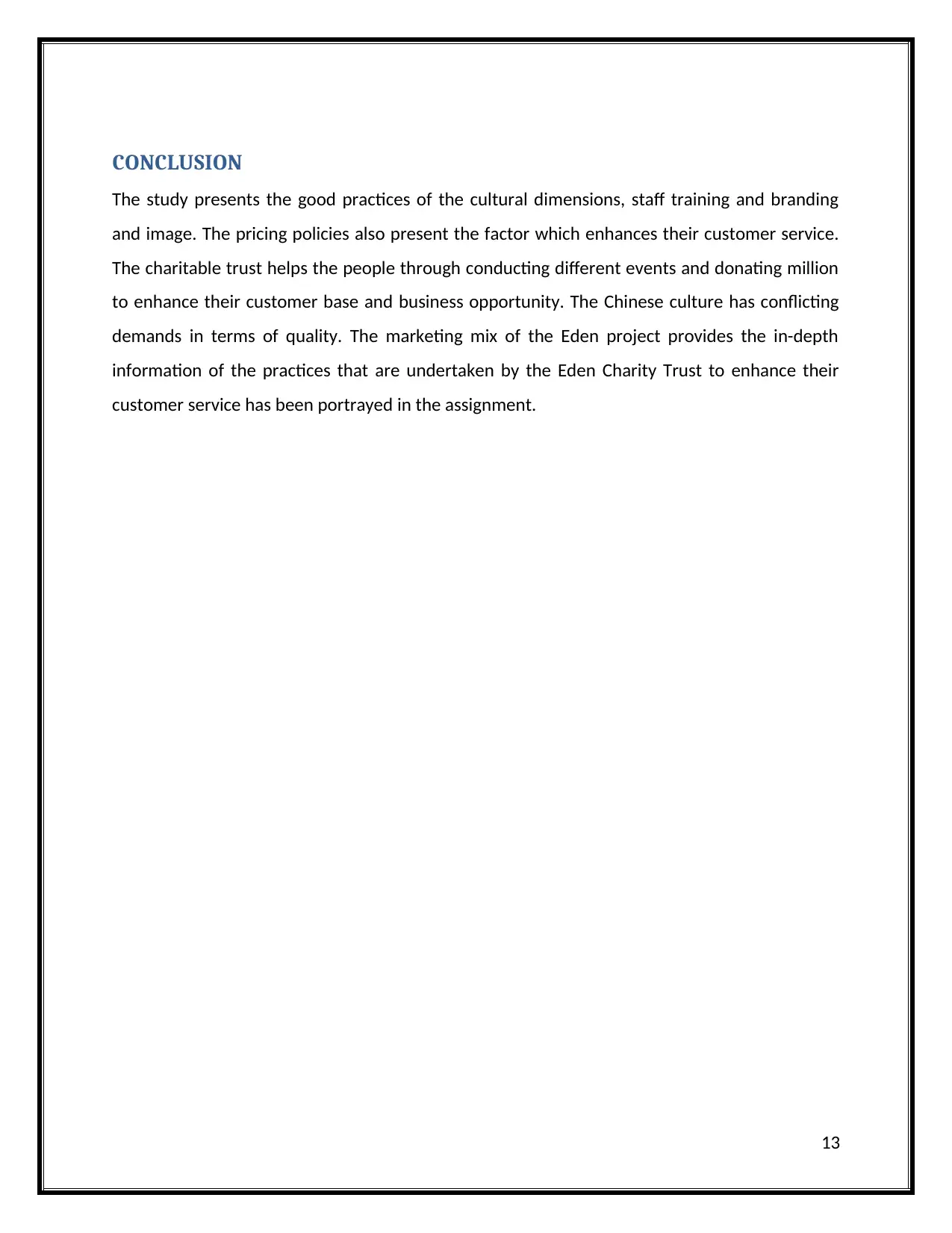
CONCLUSION
The study presents the good practices of the cultural dimensions, staff training and branding
and image. The pricing policies also present the factor which enhances their customer service.
The charitable trust helps the people through conducting different events and donating million
to enhance their customer base and business opportunity. The Chinese culture has conflicting
demands in terms of quality. The marketing mix of the Eden project provides the in-depth
information of the practices that are undertaken by the Eden Charity Trust to enhance their
customer service has been portrayed in the assignment.
13
The study presents the good practices of the cultural dimensions, staff training and branding
and image. The pricing policies also present the factor which enhances their customer service.
The charitable trust helps the people through conducting different events and donating million
to enhance their customer base and business opportunity. The Chinese culture has conflicting
demands in terms of quality. The marketing mix of the Eden project provides the in-depth
information of the practices that are undertaken by the Eden Charity Trust to enhance their
customer service has been portrayed in the assignment.
13
Paraphrase This Document
Need a fresh take? Get an instant paraphrase of this document with our AI Paraphraser
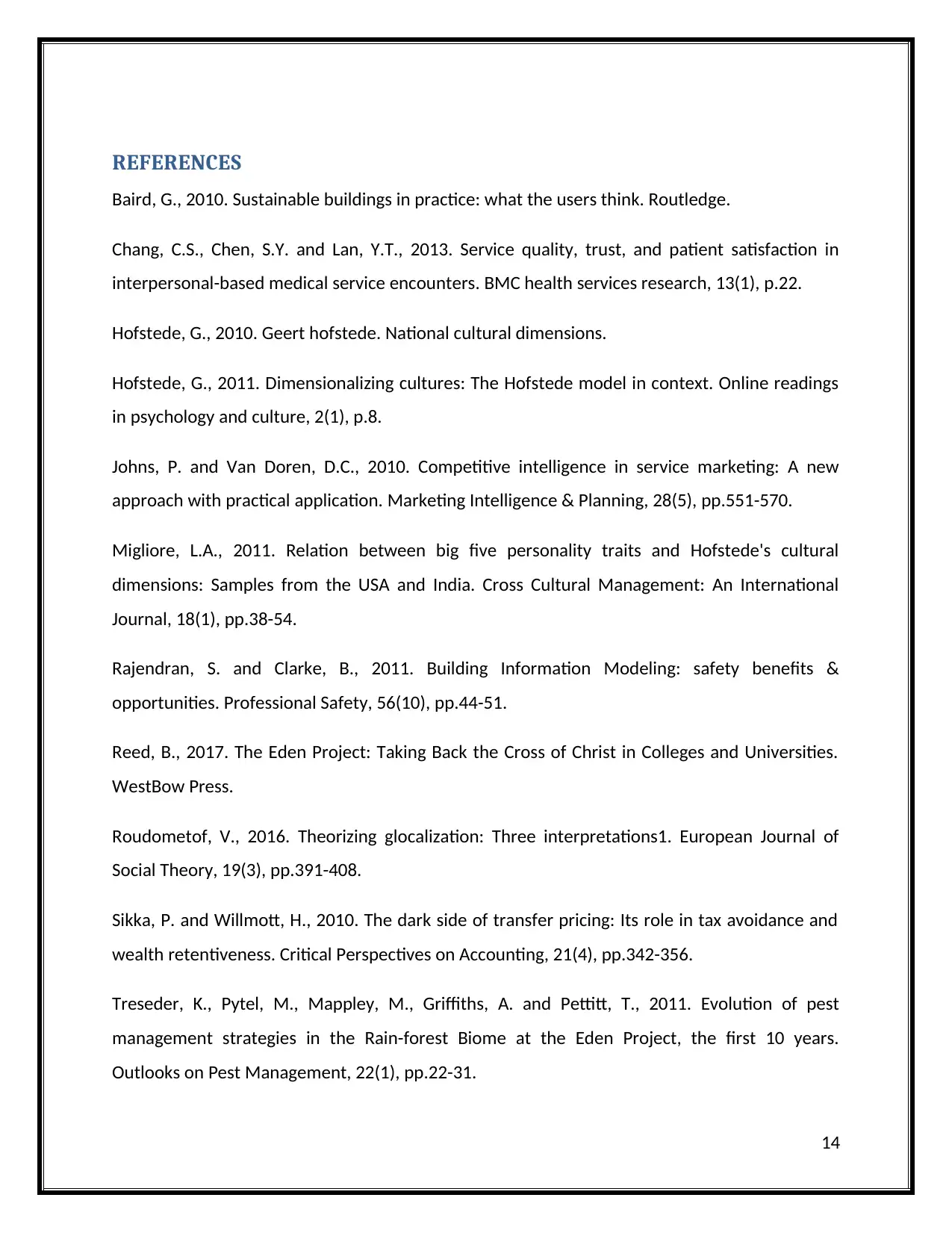
REFERENCES
Baird, G., 2010. Sustainable buildings in practice: what the users think. Routledge.
Chang, C.S., Chen, S.Y. and Lan, Y.T., 2013. Service quality, trust, and patient satisfaction in
interpersonal-based medical service encounters. BMC health services research, 13(1), p.22.
Hofstede, G., 2010. Geert hofstede. National cultural dimensions.
Hofstede, G., 2011. Dimensionalizing cultures: The Hofstede model in context. Online readings
in psychology and culture, 2(1), p.8.
Johns, P. and Van Doren, D.C., 2010. Competitive intelligence in service marketing: A new
approach with practical application. Marketing Intelligence & Planning, 28(5), pp.551-570.
Migliore, L.A., 2011. Relation between big five personality traits and Hofstede's cultural
dimensions: Samples from the USA and India. Cross Cultural Management: An International
Journal, 18(1), pp.38-54.
Rajendran, S. and Clarke, B., 2011. Building Information Modeling: safety benefits &
opportunities. Professional Safety, 56(10), pp.44-51.
Reed, B., 2017. The Eden Project: Taking Back the Cross of Christ in Colleges and Universities.
WestBow Press.
Roudometof, V., 2016. Theorizing glocalization: Three interpretations1. European Journal of
Social Theory, 19(3), pp.391-408.
Sikka, P. and Willmott, H., 2010. The dark side of transfer pricing: Its role in tax avoidance and
wealth retentiveness. Critical Perspectives on Accounting, 21(4), pp.342-356.
Treseder, K., Pytel, M., Mappley, M., Griffiths, A. and Pettitt, T., 2011. Evolution of pest
management strategies in the Rain-forest Biome at the Eden Project, the first 10 years.
Outlooks on Pest Management, 22(1), pp.22-31.
14
Baird, G., 2010. Sustainable buildings in practice: what the users think. Routledge.
Chang, C.S., Chen, S.Y. and Lan, Y.T., 2013. Service quality, trust, and patient satisfaction in
interpersonal-based medical service encounters. BMC health services research, 13(1), p.22.
Hofstede, G., 2010. Geert hofstede. National cultural dimensions.
Hofstede, G., 2011. Dimensionalizing cultures: The Hofstede model in context. Online readings
in psychology and culture, 2(1), p.8.
Johns, P. and Van Doren, D.C., 2010. Competitive intelligence in service marketing: A new
approach with practical application. Marketing Intelligence & Planning, 28(5), pp.551-570.
Migliore, L.A., 2011. Relation between big five personality traits and Hofstede's cultural
dimensions: Samples from the USA and India. Cross Cultural Management: An International
Journal, 18(1), pp.38-54.
Rajendran, S. and Clarke, B., 2011. Building Information Modeling: safety benefits &
opportunities. Professional Safety, 56(10), pp.44-51.
Reed, B., 2017. The Eden Project: Taking Back the Cross of Christ in Colleges and Universities.
WestBow Press.
Roudometof, V., 2016. Theorizing glocalization: Three interpretations1. European Journal of
Social Theory, 19(3), pp.391-408.
Sikka, P. and Willmott, H., 2010. The dark side of transfer pricing: Its role in tax avoidance and
wealth retentiveness. Critical Perspectives on Accounting, 21(4), pp.342-356.
Treseder, K., Pytel, M., Mappley, M., Griffiths, A. and Pettitt, T., 2011. Evolution of pest
management strategies in the Rain-forest Biome at the Eden Project, the first 10 years.
Outlooks on Pest Management, 22(1), pp.22-31.
14

Vliet, V.V., 2013. Service Marketing mix-7 P's. Retrieved December, 29, p.2015.
15
15
1 out of 15
![[object Object]](/_next/static/media/star-bottom.7253800d.svg)





